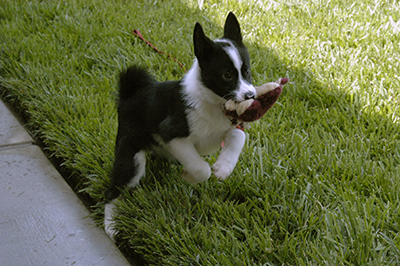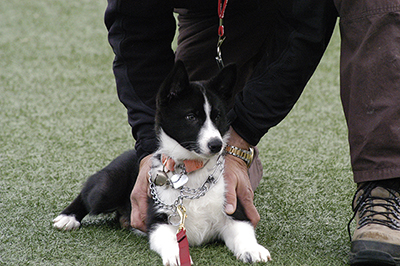How early should you start?
We begin puppy "training" at four or five weeks of age, strictly indoors. This can be continued with a puppy you have just brought home. As you plan your routine, please keep in mind that pathogens can live in grass for up to three years. Between 8 and 12 weeks of age, we introduce training outdoors on hard surfaces such as concrete or asphalt. We begin training on grass at about 12 weeks, after the puppy has received its third puppy vaccination.
Introducing the vocabulary
At this most fundamental stage, you are introducing the command words such as "lay down" and "come". (Although "sit" is also taught in Beginning Level obedience classes, we have no need for this command, as our dogs are either healing, laying, or coming. You can use your judgment here.) Keep it simple and make a game of it. Jump around to get the puppy's attention, and when she comes to you, say "Good come" and follow with hugs and kisses.

If your puppy spontaneously lies down beside you for a tummy rub, say "good lay down" in a very enthusiastic voice while gently stroking the puppy's tummy.

Practice safety as you train
As you begin training and let your puppy play freely at the end of the short training sessions, your puppy will naturally wander away from you when allowed outdoors and yet may not be fully trained on the come command. For a young puppy, your "happy voice" will be all that is needed to get your puppy to return to you, as long as you have been consistently working on bonding with your puppy.

As your puppy gets older and more curious, you will want to remember these important tips:
 Practice outdoor safety whenever your puppy is outdoors. Having a leash on your puppy--so that you can step on if she starts to run too far from you--provides an element of safety. Practice outdoor safety whenever your puppy is outdoors. Having a leash on your puppy--so that you can step on if she starts to run too far from you--provides an element of safety.

 Plan in advance how you will use toys with your dog to help speed learning. For example, a squeaky toy (that makes noise when you squeeze it) can make an excellent tool for helping to recall your puppy to you. Plan in advance how you will use toys with your dog to help speed learning. For example, a squeaky toy (that makes noise when you squeeze it) can make an excellent tool for helping to recall your puppy to you.

Show and tell
You can do a "show and tell" by gently showing your puppy what you want while simultaneously using your verbal command. At this point, you will have a leash on the puppy so he won't get away from you, but you are not yet using the leash to coax the puppy into position. Below," lay down" is being shown to the puppy by lifting her front legs out and down, placing them on the ground in front of her as Bill verbalizes the command (followed by lots of praise). Two or three of these show and tells, mixed in with play, can be done indoors or out.


The release
Now that your dog is familiar with basic vocabulary, let's say the "lay down" command. How do you communicate to your dog that you want to release them from that command, because you want them to start to walk with you? We like to say "okay" followed by the next command. You can add the dog's name after the "okay" if you wish, but we believe that introduces a longer phrase that the dog needs to comprehend (which introduces an element of difficulty).
Leash training
As the puppy begins to learn, and resist your "show and tell" less, you can begin leash training. Using the leash, you will be gently demonstrate what you want as you give the command, always using an enthusiastic, upbeat voice. Under four months of age, no corrections should be given. Instead, gently help your puppy get into the position you want (sit or lay down at your left side) as you give the command. Once the dog connects the word with the action, lots and lots of praise are in order. After one or two successful bahaviors, end the training session, before your dog's attention starts to wander.

At this stage, give the command the first time in a positive, upbeat voice, then give your dog five full seconds to comply. If he does not obey, follow up with the command word a second time in a more commanding (but not angry) voice. The third time, a gentle physical demonstration of the command is necessary.
Corrections and consistency
Once your puppy is four months old, you can begin gentle leash corrections. Continue giving the command the first time in a very enthusiastic, upbeat voice. Count to five, and use a firm voice the second time, if necessary. After another count to five, if she still ignores the second time, say "No" as you correct her, and give the command a third time (again, firmly but not with anger). If you find yourself correcting frequently, you may find it helpful to increase the frequency of your training sessions and decrease the duration, always making sure you end with a successful behavior.
During leash training, it is important to select the right collar. We use several types, depending on the age of the puppy and how the puppy is responding to our commands. A choke collar is a metal chain collar. We start training our puppies using a choke or plastic prong collar. The plastic prongs simulate how their mother gently bites her puppies to help manage their behavior. At four to five months of age, you may need a metal prong collar, when the thick neck fur prevents the dog from feeling the prongs when you apply a normal amount of force to the leash.
It is crucial that you know your dog, know what it is capable of doing, and don't ask it to do anything that you are not in a position to reinforce. Indoors and outdoors, puppies should be wearing a leash at all times so that, when you ask the puppy to "come", you can pick up the end of the leash and gently pull the puppy toward you to reinforce that "come" command if necessary. Otherwise, you will quickly teach your dog that your "commands" are nothing more than optional "requests." Below, a long 20-foot leash works wonders when teaching the come command from longer distances.




Patience (combined with lots of praise) is important as you and your dog develop a partnership without imparting training scars. When you are ready to introduce a heightened degree of difficulty, you might want to introduce the three D's into your training program. |
End on a success
As a general rule, consistent daily training sessions that last three to ten minutes are far more effective than weekly sessions lasting 30 minutes. Frequent reinforcement of successful behavior is key. In fact, every training session should end on a success. What exactly does that mean?
The first time your puppy gives you a correct response for a new command you are introducing, end the training session right there and praise profusely. This will be far more effective than lengthening the training session beyond the dog's concentration.

Then, try for two correct responses for two or three sessions before asking for three correct responses. If your dog appears to regress, seeming to have forgotten what you thought he had already mastered, reinforce the behavior by expecting less for a few training sessions. Don't try to move too fast. It's not a contest. Training should be fun for you and your dog.
|